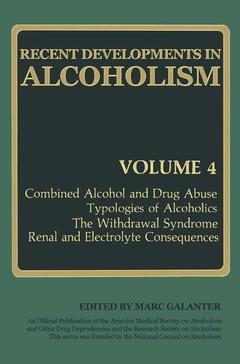Recent Developments in Alcoholism, Softcover reprint of the original 1st ed. 1986 Combined Alcohol and Drug Abuse Typologies of Alcoholics The Withdrawal Syndrome Renal and Electrolyte Consequences Recent Developments in Alcoholism Series, Vol. 4
Langue : Anglais
Coordonnateur : Galanter Marc

From the President of the Research Society on Alcoholism In recent years the alcohol research field has matured and is attracting a substantial number of eager and technically sophisticated researchers. There is a feeling of excitement and premonitions of breakthroughs as more and more of alcohol's actions are being detailed. I, however, have at times been sobered by the perception that the lure of parsimonious explanations and the appeal of studying easily demonstrable effects obscure the critical issues re garding alcohol abuse and alcoholism. Central questions regarding (1) the reinforcing properties of ethanol and other factors responsible for inappro priate consumption of alcohol, (2) the heterogenous characteristics (both bi ologic and sociologic) of the alcoholic population, and (3) the differential predisposition of individuals to alcohol-induced medical problems needed to be vigorously pursued. Researchers who used animals as models for the human condition needed to become more intimately aware of the variety of factors that are of importance in the development of alcoholism in an indi vidual. On the other hand, researchers studying humans needed to attempt to more clearly define and categorize diagnostic criteria and characteristics of various alcoholic populations. Such categorization and continued character ization of alcoholism allows not only for a framework of concepts within which proper animal models for studies of biologic mechanisms can be de veloped but also allows for consideration of the most apt treatment approaches.
I. Combined Alcohol and Drug Abuse Problems.- 1 Multiple Drug Use: Epidemiology, Correlates, and Consequences.- 2 Mechanisms of Depressant Drug Action/Interaction.- 3 Sedative Drug Interactions of Clinical Importance.- 4 Treating Multiple Substance Abuse Clients.- II. Typologies of Alcoholics.- 5 Classification and Forms of Inebriety: Historical Antecedents of Alcoholic Typologies.- 6 Empirically Derived Classifications of Alcohol-Related Problems.- 7 An Examination of Selected Typologies: Hyperactivity, Familial, and Antisocial Alcoholism.- 8 Alcoholic Typologies: A Review of Empirical Evaluations of Common Classification Schemes.- 9 Alcoholic Subtypes Based on Multiple Assessment Domains: Validation against Treatment Outcome.- III. The Alcohol Withdrawal Syndrome.- 10 The Alcohol Withdrawal Syndrome: A View from the Laboratory.- 11 Clinical Neuroendocrinology and Neuropharmacology of Alcohol Withdrawal.- 12 Clinical Assessment and Pharmacotherapy of the Alcohol Withdrawal Syndrome.- 13 Special Aspects of Human Alcohol Withdrawal.- IV. Renal and Electrolyte Consequences of Alcohol Abuse.- 14 Disorders of the Serum Electrolytes, Acid-Base Balance, and Renal Function in Alcoholism.- 15 Urinary Tract Infections and Renal Papillary Necrosis in Alcoholism.- 16 Disorders of Divalent Ions and Vitamin D Metabolism in Chronic Alcoholism.- 17 The Pathogenesis of Renal Sodium Retention and Ascites Formation in Laennec’s Cirrhosis.
Date de parution : 06-2013
Ouvrage de 454 p.
15.5x23.5 cm
Thèmes de Recent Developments in Alcoholism :
Mots-clés :
Syndrom; assessment; epidemiology; ethanol; feeling; hyperactivity
© 2024 LAVOISIER S.A.S.



